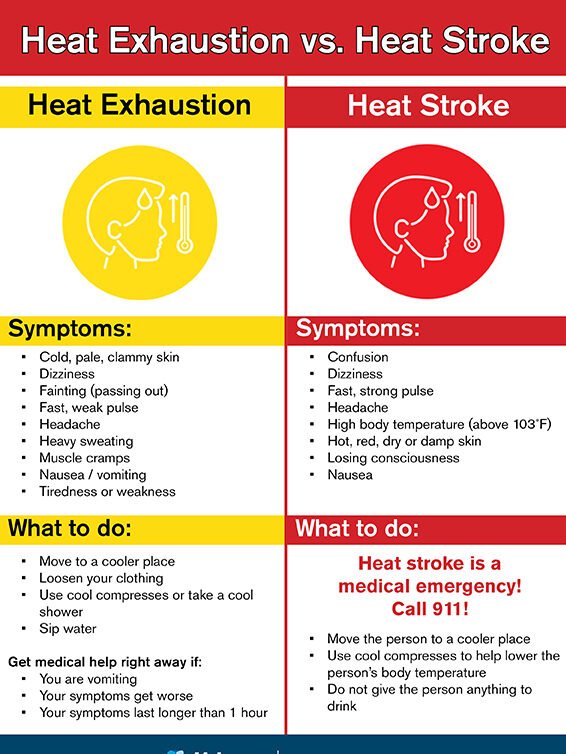As extreme temperatures sweep across many parts of the world, heat-related illnesses are on the rise. Among them, heat stroke is the most serious and potentially life-threatening condition caused by extreme heat. Knowing the symptoms of heat stroke is not just helpful — it can save lives.
Whether you’re spending long hours outside or stuck in a hot environment with limited airflow, recognizing the early signs of heat stroke is crucial. In this article, we’ll break down what heat stroke is, its symptoms, how it differs from other heat-related illnesses, and what you should do if you or someone else shows warning signs.
What Is Heat Stroke?
Heat stroke is a severe heat-related illness that occurs when your body overheats and is unable to cool down. It typically happens when the body temperature rises above 104°F (40°C). Unlike heat exhaustion, heat stroke can cause serious damage to the brain, heart, kidneys, and muscles if not treated quickly.
Heat stroke can affect anyone — but children, the elderly, and those with chronic illnesses are at higher risk. People who work or exercise outdoors in hot, humid weather are also particularly vulnerable.
Common Symptoms of Heat Stroke
The symptoms of heat stroke may vary slightly from person to person, but the most common signs include:
1. High Body Temperature
- A core body temperature of 104°F (40°C) or higher is the main sign of heat stroke.
- This is often measured with a rectal thermometer in medical settings.
2. Altered Mental State or Behavior
- Confusion, slurred speech, irritability, agitation, or seizures.
- In severe cases, the person may fall unconscious or go into a coma.
3. Hot, Dry Skin
- Skin may feel dry to the touch due to the body’s failure to sweat.
- In some cases, skin may be slightly moist if the heat stroke is caused by physical exertion.
4. Rapid Heartbeat and Breathing
- The heart rate increases as the body tries to cool itself.
- You may also notice shallow, fast breathing.
5. Headache
- A throbbing headache that gets worse can be an early sign.
6. Nausea and Vomiting
- The person may feel sick or vomit without warning.
7. Muscle Cramps or Weakness
- Especially common in exertional heat stroke, which occurs during intense physical activity in the heat.
Difference Between Heat Stroke and Heat Exhaustion
It’s easy to confuse heat stroke with heat exhaustion, but they are not the same. Here’s how they differ:
| Feature | Heat Exhaustion | Heat Stroke |
|---|---|---|
| Body Temperature | Usually below 104°F (40°C) | 104°F (40°C) or higher |
| Sweating | Heavy sweating | Little or no sweating (hot, dry skin) |
| Mental State | Fatigue, dizziness | Confusion, agitation, possible unconsciousness |
| Urgency | Needs cooling and rest | Medical emergency – call 911 immediately |
What Causes Heat Stroke?

Several factors can lead to heat stroke, especially during extreme heat waves:
1. Prolonged Exposure to High Temperatures
- Being outside for long periods without shade or cooling can overwhelm the body’s ability to regulate temperature.
2. Physical Activity in Hot Conditions
- Athletes, construction workers, and outdoor laborers are at high risk.
3. Dehydration
- Lack of water reduces the body’s ability to sweat and cool down naturally.
4. Wearing Heavy or Dark Clothing
- This traps heat and prevents sweat evaporation.
5. Poor Ventilation Indoors
- Even inside, rooms without airflow or air conditioning can become dangerously hot.
Who Is Most at Risk?
Understanding who is vulnerable can help protect those who need it most:
- Older adults (65+ years)
- Infants and children
- People with chronic illnesses (heart disease, diabetes, respiratory issues)
- Athletes and outdoor workers
- People without access to cooling (AC, fans, etc.)
- Individuals on medications like diuretics, antihistamines, or beta blockers, which affect temperature regulation
First Aid: What to Do If You Suspect Heat Stroke
If someone shows symptoms of heat stroke, take immediate action. This is a medical emergency.
Call Emergency Services (911 or your local number) Immediately.
While waiting for help, do the following:
- Move the person to a cooler place. Indoors or under shade.
- Remove excess clothing. Lighten clothing to help body cool.
- Cool the body quickly.
- Use a cold bath or shower if available.
- Apply cold, wet cloths to the body.
- Use fans, ice packs, or a spray bottle with cold water.
- Hydration: If the person is conscious and alert, offer cool (not icy) water. Do not give fluids if they are confused or unconscious.
Never delay treatment. The longer the body stays overheated, the greater the risk of severe complications or death.
How to Prevent Heat Stroke
Avoiding heat stroke is often a matter of common sense, but during extreme heat warnings, extra precautions are critical.
1. Stay Hydrated
- Drink water frequently, even if you’re not thirsty.
- Avoid alcohol, caffeine, and sugary drinks that lead to dehydration.
2. Dress for the Weather
- Wear lightweight, loose-fitting, light-colored clothing.
- Use a wide-brimmed hat and sunglasses outdoors.
3. Plan Outdoor Activities Carefully
- Avoid strenuous activity during peak sun hours (10 AM – 4 PM).
- Take breaks in the shade or air-conditioned spaces.
4. Use Fans and Air Conditioning
- If AC isn’t available, go to public places like malls, libraries, or cooling centers.
5. Never Leave Anyone in a Parked Car
- Temperatures can rise dangerously in just minutes, even with windows cracked.
6. Check on Vulnerable People
- Elderly neighbors, young children, and those with health conditions should be monitored regularly during heatwaves.
Warning Signs You Shouldn’t Ignore
If you or someone around you shows these signs, act fast:
- Sudden confusion or trouble speaking
- Body feels extremely hot but isn’t sweating
- Rapid pulse or shallow breathing
- Loss of consciousness
- Seizures or twitching muscles
Why Heat Stroke Is a Growing Concern
With climate change leading to more frequent and intense heat waves, heat-related illnesses are becoming more common. Urban areas, known as heat islands, retain more heat due to concrete, asphalt, and fewer trees, making city dwellers especially vulnerable.
According to health experts, the number of heat stroke-related ER visits spikes during heat alerts — many of which could be prevented with better awareness and precautions.
Final Thoughts
The symptoms of heat stroke are serious, and recognizing them early can be lifesaving. As temperatures rise across the globe, it’s more important than ever to educate ourselves and others.
By staying hydrated, dressing appropriately, avoiding outdoor activities during peak heat, and checking in on at-risk individuals, we can all play a role in preventing heat stroke and other heat-related illnesses.
If you suspect heat stroke, don’t wait act fast. Your quick response can save a life.
Read Next – New COVID Variant Symptoms: What You Need to Know Now






